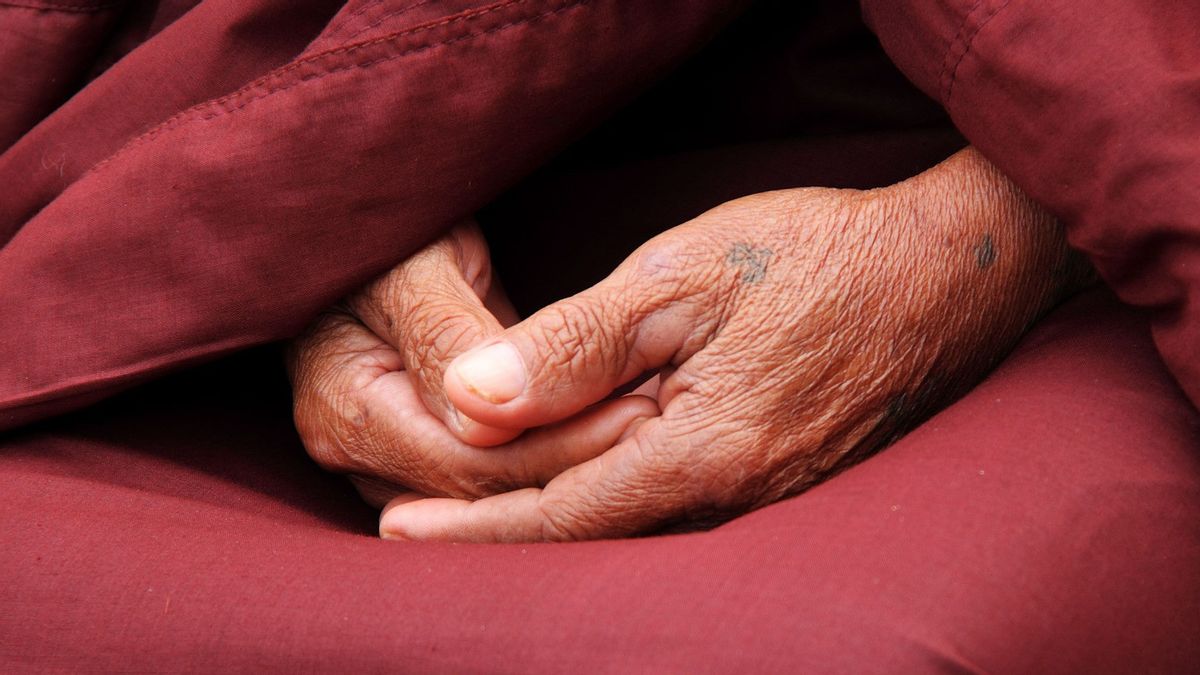JAKARTA - Humans are two-dimensional creatures, namely the physical dimension and the spirit or spiritual dimension. These two dimensions will influence each other. When a person is physically sick or injured, his soul and mind will be disturbed. Not a few physical ailments arise due to defilement of the soul or mind.
Meditation is nothing but another language of calm, which is trying to stabilize the soul and mind back to zero. If many physical ailments arise from defilements of the soul and mind, then the healing can be initiated through cleansing of the soul and mind. This is what meditation offers as a medium for self-healing.
But here self-healing focuses on psychological healing first. Cleanse the soul from bad things that pollute it such as revenge, jealousy, pride, etc. Meanwhile, physical ailments will automatically disappear with a clean mind and soul.
Recognizing Meditation as a Self-Healing MediaMeditation is a very old art of mind control. Every religion and culture in the world basically has it in different forms and it still continues today. However, the most famous in this regard is Hindu-Buddhist religion and culture.
Currently, many people use meditation as a medium for self-healing (both mental and physical illness), a medium for relaxation, or as a medium for seeking happiness (the persuit of happiness). In various places around the world, meditation places or retreats are opened without any religious restrictions. In the West itself, since 40 years ago meditation has entered the center of health care.
Scientifically, meditation has been shown to relieve chronic stress, a condition that scientists believe is the cause of many ailments. It was also found that meditation can improve heart health, relieve all symptoms of disease and improve the short and long term brain health.

One of the most popular studies came from the Keck Laboratory for Functional Brain Imaging and Behavior in Wisconsin. The team, led by neuroscientist Richard Davidson, showed the results of brain scans of a meditator and found that his brain activity exceeds that of a professional athlete in tough competition.
But at that point, scientists still don't know how meditation actually works, research shows that meditation does work and can change the brain for the better. Perhaps one thing scientists should note is that meditation appears to produce an anti-stress biochemical reaction that neutralizes the biochemical reactions that cause stress.
During meditation, the body produces nitric oxide, a chemical used by pharmaceutical companies to lower blood pressure. (Do not confuse it with nitrous oxide, which is used by dentists as an anesthetic or used by addicts.) Nitric oxide lowers blood pressure by enlarging blood vessels to stop pressure on the heart.
Jeffrey Dusek, a psychobiologist who teaches at Harvard Medical School and a research associate director at the Mind / Body Institute on Chestnut Hill, explains how meditation works as much as pharmacy does.
“It has been proven that when you meditate, or yoga, or tai chi or other means, it actually reduces blood pressure. The reaction to meditation practice, relaxation, may apply the same to what pharmaceuticals do, altering the body's capacity to release nitric oxide. So we thought we were using a biological mechanism to find out how meditation works, "explains Jeffrey Dusek.
In line with the above, Stephen Bodian, author of "Meditation for Dummies", explains that meditation helps people who feel sick get better, and those who feel good get better. Everything rests on one's happiness and happiness is the root of all healing.
"The goal is happiness," explained Bodian. "What kind of effect does happiness have? Isn't this because we are doing therapy? Happiness is the highest healer. "
In his research, Bodian found that meditation can change the brain for the better. This includes raising the emotional pivotal point which is the natural inner state that people struggle with all their life. Some people go down naturally; some increase naturally. Bodian believes meditation can improve it permanently.
Bodian also added that the health produced by meditation is showing a decrease in blood pressure, boosting the immune system and increasing levels of relaxation.
After knowing that meditation can be an effective medium for self-healing, then knowing the types of meditation that can be used. Research sponsored by the NCCAM found two main types of meditation: mindfulness meditation, in which a person focuses on becoming aware in the present moment, and Transcendental meditation, which uses mantra repetition.
You can use one of the two types of meditation above. Research did not find large differences between the results of mindfulness meditation or transcendental meditation. The following is an explanation of these two types of meditation.

Mindfulness meditation is the most common meditation practice. It could be that your knowledge of meditation is mindfulness meditation itself. Meditation by sitting up straight, eyes closed, and focusing on the breath that is done deeply and slowly is called mindfulness meditation.
Mindfulness meditation is the most popular type of meditation and is recommended because it is fairly easy to do for all people and is suitable for beginners who want to start meditating. This meditation is also the most popular type of meditation in the Western World. The word "mindfulness" itself is an English translation of Anapanasati, a part of the traditional Buddhist meditation practice, Vipasana.
However, it is important to remember that mindfulness meditation is free from various ideologies and religious perspectives. An important component of this meditation is mindfulness, the ability to focus on the present without giving interpretation, openness and acceptance to the present.
In addition, in general mindfulness meditation does not focus on a planned object or point such as concentrated meditation, but allows thoughts and feelings to cross the mind in the present. How to explain this objectless meditation, because usually we concentrate by focusing on a particular object.
In order to understand this situation more clearly, for example when you are in a place, a certain object draws your eye to it, but awareness allows you to enjoy the view.
Enjoyment or satisfaction from seeing a scene does not come from seeing the object, but comes from awareness of what is seen. Physiological shifts, tranquility of the body, enjoyment of freedom of the soul are all part of the scene. When you focus, you only see the breath.
Now here is the meaning of meditation without a specific object. In mindfulness meditation, you don't have any new objects to focus on. It's more about shifting your emphasis when you meditate from focus to watching, from awareness to spotlight awareness. The point is in mindfulness meditation, you become an audience.
In ordinary meditation, you focus your heart and mind on a specific object. Whereas in mindfulness meditation you do the opposite. This doesn't mean it doesn't have a focal point. You still have a focal point, which can be anything, but most of your attention goes outside, "just watching" the passing thoughts and sensations.
For clarity, it can also be seen how different it is from formal breathing meditation. In breathing meditation, you will only see other thoughts and sensations when they attract your attention. When practicing mindfulness, however, you can still focus on the breath, but you allow other thoughts to surface. You deliberately see them through consciousness.
Mindfulness meditation trains you to maintain neutral thoughts. You are like a mirror. You don't think about what happened. You don't pursue good things or fight against bad. You only see what has walked in and out the door of your mind without giving any reaction. As you can imagine, this doesn't come easy. Some visitors are very tempting.
For example, suppose you just came home from work with a lot of problems, whether it's a job that hasn't been completed, a friend who doesn't like you, or your boss's anger because of a deadline you didn't meet. These are all semi-conscious irritants that won't go away if you try to ignore them. They must exit through the front door.
When you start to sit quietly with a deep breath, all the clutter and cloudiness of the mind begins to clear up. Once you've registered your feelings and can see that further thinking won't help, it's easier to let them go.
This part needs to be the main concern that awareness does not solve problems from the outside, because it will only change the shape of your reaction to it. You stop fighting your imperfections in the moment and let things happen. You see all the troubles go past you and feel the disturbances fade away; your breath feels soft and beautiful. And all is well if it just flows.
On a larger scale, doing mindfulness meditation means trying to become comfortable with an uncomfortable world. You may be inclined to feel that you can't relax until all the problems are resolved, but this is an unhealthy attitude. Problems are things that never move from life. If you want to be happy, this is the time.
The question is, how to practice or get used to mindfulness meditation? You can start by practicing by following these simple steps and making it a daily routine.
1. Find a quiet and comfortable place to sit.
2. Use good posture; don't slouch.
3. Close your eyes and take a deep breath, letting the air fill your entire lungs. Some people call it belly breathing.
4. Focus on your breath. When your mind wanders, bring it back with a focus on your breathing. Be gentle with yourself. Your mind will wander into the past and try to predict the future. It is natural. Immediately refocus on your breathing.
4. As you breathe, allow your mind to scan your shoulders, one or both, for tension. Release the tension and continue your breathing.
5. Do the same with your hands, chest, stomach, legs.
6. Return your mind to your breath and return to observing the body.
7. After 30 minutes, open your eyes, take a deep breath and come back to your life.
Transcendental MeditationAs explained in the introduction to this paper, humans are two-dimensional beings, namely the physical (biological) dimension and the soul (spiritual) dimension. As a biological creature consisting of cells that form organs, it will develop into an organismic creature that has certain characteristics.
Meanwhile, as a spiritual being, humans do not only relate to other people in the system of society or the world, but they also relate to the Creator. He recognized that there was a force outside of himself that had a lot to do with his life. After various attempts he made and failed, he would surrender himself to this power.
Life is dynamic where everything changes continuously. This change does not only apply to what is outside of man, but also applies to man himself. All forms of these changes, all of which can cause stress or pressure resulting in disruption of the balance in the individual.
It is human nature, when an imbalance occurs, his soul will encourage him to try to find his balance again. In this case, various efforts will be made by humans to maintain this balance.
One of the efforts to get a balance in living a life full of problems and changes is by doing meditation. The ultimate goal to be achieved in this way is the expansion of self-awareness and transcendence. And one of the popular meditations in this case is transcendental meditation.
Transcendental meditation is a meditation activity carried out using a word (mantra) which is believed to increase concentration on the subject. For information, this type of meditation is also practiced by international celebrities such as Lady Gaga and Oprah Winfrey.
They both believe that transcendental meditation plays a huge role in the success they are now experiencing. In a television interview in 2018, Oprah confessed that transcendental meditation has made big positive changes in her life.
Before we talk about how to do this meditation, it is good to describe the great benefits of this meditation apart from the general benefits that have been explained in the introduction to this paper.
Apart from the health effects of transcendental meditation, many people have claimed this type of meditation greatly helps them in improving their quality of life. Transcendental meditation helps us to achieve a positive state of mind and a deep feeling of peace. Here are the benefits of this meditation.
1. Develop mental potential which is useful for:
- Make the mind clearer, more focused
- Increase intelligence (IQ)
- Improve memory (memory)
- Increase the integration of brain functions
- Increase the ability to innovate
- Improve study skills
2. Improve health, namely:
- Overcoming stress
- Produces deep rest
- Increase calm
- Reduces high blood pressure
- Reduces thickening of the walls of blood vessels
- Reduces anxiety
- Lowering insulin resistance for people with diabetes and heart disease
- Slowing down the biological age (being younger)
3. Increase social behavior, namely:
- Increase appreciation of others
- Increase job satisfaction
- Improve relationships with superiors
- Improve relationships with colleagues and friends
- Increase the adaptability in physiology, psychology, sociology and ecology.
How do you do this meditation so that it can become a daily routine? To get started, you can follow these simple steps.
1. Start in a comfortable sitting position, but try not to cross your legs and arms.
2. Close your eyes and take a deep breath and feel your body begin to relax.
3. Open the eyes and close them again. Then keep your eyes closed during the exercise for about 20 minutes.
4. Repeat the mantra in our mind (the mantra that is recited is usually from the Vedic tradition, but you can use certain prayers that you believe in)
5. When you notice that you are thinking, return to the mantra, and so on.
6. After 20 minutes, start moving your fingers and toes to make it easier for us to return to our present awareness.
7. Open your eyes
8. Sit for a few more minutes until you feel ready to move on with the day.
These are the two types of meditation that you can use as a medium for self-healing. Hopefully useful and can make your life happier in the days to come.
The English, Chinese, Japanese, Arabic, and French versions are automatically generated by the AI. So there may still be inaccuracies in translating, please always see Indonesian as our main language. (system supported by DigitalSiber.id)









